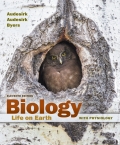
Concept explainers
Which trophic level(s) must be present to sustain any ecosystem?
producers only
producers and consumers
producers, detritivores, and decomposers
producers, consumers, detritivores, and decomposers
Introduction:
The ecosystem is sustained by the interaction of biotic (living organisms) and abiotic components (like climate, environment, water, and soil). Each organism in the biotic component is categorized in various trophic levels through which energy passes. To sustain an ecosystem, a healthy interaction among different components present in the ecosystem is necessary. The members of biotic component seek their nutritional support from the abiotic component of the ecosystem and return the nutrients back into the abiotic pool at each trophic level. Thus, the nutrients and energy keep recycling in the ecosystem.
Answer to Problem 1MC
Correct answer:
To sustain an ecosystem producers, consumers, detritivores, and decomposers must be present. All tropic levels are necessary to keep the nutrient cycle going.
Explanation of Solution
Explanation for the correct answer:
Option (d) is given as producers, consumers, detritivores, and decomposers. All these are required to sustain an ecosystem. This statement is true because in any ecosystem, the energy flows from one trophic level to the next. Every trophic level has its own purpose in an ecosystem. The first trophic level is producers or autotrophs that are capable of producing food themselves. Consumers are organism that obtains food by feeding on producers or other organisms. Detritivores and decomposers are responsible for the decomposition of dead and waste material. Thus, all tropic levels maintain the ecosystem. Therefore, option (d) is a correct answer.
Explanation for incorrect answers:
Option (a) is given that producers only are able to uphold any ecosystem. This is false because if only producers would be present, their number would increase tremendously and no organism would be present to eat or decompose them. This would cease the nutrient flow and eventually ecosystem would collapse. So, it is an incorrect answer.
Option (b) is given that only producers and consumers can support any ecosystem. This statement is false as the energy will flow from producers to consumers but without detritivores and decomposers, dead and waste material would accumulate. The absence of decomposition would terminate the availability of nutrients for the producers. Thus, their growth would cease, resulting in their death, hence disintegration of the ecosystem would occur. So, it is an incorrect answer.
Option (c) is given as producers, detritivores, and decomposers. Consumers are organism that obtains food by feeding on other organisms or organic matter due to lack of the ability to manufacture own food from inorganic sources. Absence of any of these levels disrupts the energy flow, due to which the ecosystem would collapse. So, it is an incorrect answer.
Hence, options (a), (b), and (c) are incorrect.
Thus, it can be concluded that all trophic levels hold a unique place in an ecosystem. It is through each trophic level that the energy travels in the ecosystem in the form of nutrients, thus maintaining nutrient cycle and supporting the ecosystem.
Want to see more full solutions like this?
Chapter 29 Solutions
EBK BIOLOGY
Additional Science Textbook Solutions
Cosmic Perspective Fundamentals
Chemistry: An Introduction to General, Organic, and Biological Chemistry (13th Edition)
Organic Chemistry (8th Edition)
Campbell Biology (11th Edition)
Microbiology: An Introduction
Campbell Essential Biology (7th Edition)
- 1. Match each vocabulary term to its best descriptor A. affinity B. efficacy C. inert D. mimic E. how drugs move through body F. how drugs bind Kd Bmax Agonist Antagonist Pharmacokinetics Pharmacodynamicsarrow_forward50 mg dose of a drug is given orally to a patient. The bioavailability of the drug is 0.2. What is the volume of distribution of the drug if the plasma concentration is 1 mg/L? Be sure to provide units.arrow_forwardDetermine Kd and Bmax from the following Scatchard plot. Make sure to include units.arrow_forward
- Choose a catecholamine neurotransmitter and describe/draw the components of the synapse important for its signaling including synthesis, packaging into vesicles, receptors, transporters/degradative enzymes. Describe 2 drugs that can act on this system.arrow_forwardThe following figure is from Caterina et al. The capsaicin receptor: a heat activated ion channel in the pain pathway. Nature, 1997. Black boxes indicate capsaicin, white circles indicate resinferatoxin. a) Which has a higher potency? b) Which is has a higher efficacy? c) What is the approximate Kd of capsaicin in uM? (you can round to the nearest power of 10)arrow_forwardWhat is the rate-limiting-step for serotonin synthesis?arrow_forward
 Human Biology (MindTap Course List)BiologyISBN:9781305112100Author:Cecie Starr, Beverly McMillanPublisher:Cengage Learning
Human Biology (MindTap Course List)BiologyISBN:9781305112100Author:Cecie Starr, Beverly McMillanPublisher:Cengage Learning
 Biology 2eBiologyISBN:9781947172517Author:Matthew Douglas, Jung Choi, Mary Ann ClarkPublisher:OpenStax
Biology 2eBiologyISBN:9781947172517Author:Matthew Douglas, Jung Choi, Mary Ann ClarkPublisher:OpenStax Biology: The Unity and Diversity of Life (MindTap...BiologyISBN:9781305073951Author:Cecie Starr, Ralph Taggart, Christine Evers, Lisa StarrPublisher:Cengage Learning
Biology: The Unity and Diversity of Life (MindTap...BiologyISBN:9781305073951Author:Cecie Starr, Ralph Taggart, Christine Evers, Lisa StarrPublisher:Cengage Learning Concepts of BiologyBiologyISBN:9781938168116Author:Samantha Fowler, Rebecca Roush, James WisePublisher:OpenStax College
Concepts of BiologyBiologyISBN:9781938168116Author:Samantha Fowler, Rebecca Roush, James WisePublisher:OpenStax College





